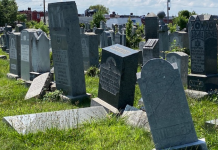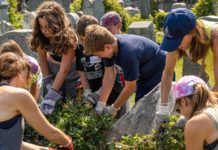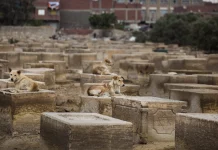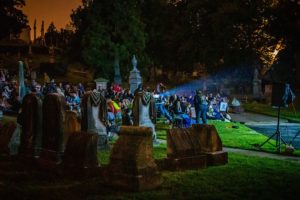
“We might be a cemetery, but our social life isn’t dead,” reads the description of the Friends of Laurel Hill Facebook page.
At first, the morbid tagline sounds like a joke, but if you were to show up at Bala Cynwyd’s Laurel Hill West cemetery on a Friday evening, you may find a smattering of people sitting on the grass enjoying a film for a Cinema in the Cemetery event. Once a year, you could stumble upon the Market of the Macabre at Laurel Hill East, with dozens of vendors selling their wares.
The Philadelphia and Bala Cynwyd cemetery, founded in 1836 and home to the predominantly Jewish Laurel Hill West section, has gotten creative with its programming as a way to keep the cemetery gates open.
Its business model is a solution to a common problem among cemeteries, especially Jewish ones. As cemeteries bury fewer people and run out of funds to maintain their grounds, they must find alternative ways to generate revenue.
Some Philadelphia Jewish cemeteries are “in deep doo-doo,” worries Harry Neel, consumer service council for the Pennsylvania Cemetery Cremation and Funeral Association.
Jewish cemeteries are old, and many predate endowment care laws, which mandate that cemeteries set aside funds into a trust fund; around 15% of profits from each grave must go into the fund, providing a safety net for the cemetery’s longevity.
In North Philadelphia, home of many Jewish cemeteries in the area, the neighborhoods have changed since the cemeteries opened, with fewer Jews living in that part of the city. Younger people have different values than the older generation, wanting to bury their loved ones in a nondenominational cemetery, Neel posited. Others may not pay for long-term care of the grave.
Lack of proper funds is what leads to a lack of maintenance: broken gravestones, overgrown grass and uneven land.
“Someday, when you’re out of land, when you have no burials to make anymore — no land to sell, no burials to make, no markers to sell, no anything — what’s going to cut the grass?” Neel said.
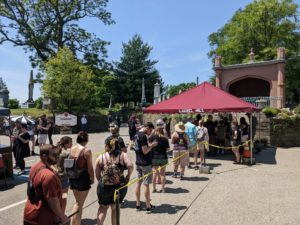
Some Jewish cemeteries are turning to help from organizations, such as Friends of Jewish Cemeteries, a Jewish Federation of Greater Philadelphia special initiative that, with community funding, has pilot projects to repair graves at Har Nebo and Har Yehuda cemeteries.
Though the scope of the project is limited in how much of a cemetery it can repair, it provides exposure to a widespread problem to the greater community.
“It allows us to see tangible results that are building awareness and visibility, that all of us can make a difference, that all of us can change the tide of despair,” FJC leader Rich Blumberg said.
Laurel Hill’s roster of programming was designed for a similar purpose. Cemeteries were, at their founding, made to be beautiful to attract the attention of individuals for potential business.
“Generating revenue is nothing new,” Laurel Hill President and CEO Nancy Goldenberg said. “From the get-go of the creation of cemeteries, they were money-making businesses.”
Laurel Hill is no exception. Cemetery founder John J. Smith bought several lots of land next to the Schuylkill and later, in Bala Cynwyd.
“They were always meant to be beautiful, open spaces,” Goldenberg said. “Cemeteries are the precursors of parks. There were no parks in 1836. There was no art museum in 1836. There was no public sculpture in 1836.”
Though Laurel Hill thrived for over a century as a bucolic respite in the city, it, along with other urban cemeteries, suffered in the 1960s and ‘70s, due to the disinvestment from cities because of rising economic and racial tensions.
In 1978, historian John Francis Marion and a small cohort he assembled began giving historic tours of cemeteries, pointing out historical figures buried at the cemetery, to generate revenue. The tour group was the beginning of Friends of Laurel Hill.
This month, Laurel Hill opened Makom Shalom, a new section of Laurel Hill West, which will contain 906 graves across three acres. It’s a testament to the cemetery’s financial health, Goldenberg said. Laurel Hill continues to offer book clubs, cemetery tours and performances to visitors.
However, with more creative programming, though it helps attract a wider audience, Laurel Hill must still honor its roots as a place of grieving, maintaining a balance between fun activities and respect for the dead. Goldenberg believes that finding a way to keep business alive will keep graves maintained and welcoming to loved ones, the cemetery’s highest
priority.
“Our industry is a business. Businesses have to generate revenue,” Goldenberg said. “If we don’t, we’re not able to maintain the graves of those who are buried here, and we’re not able to uphold the commitment that we promised to our families.”



